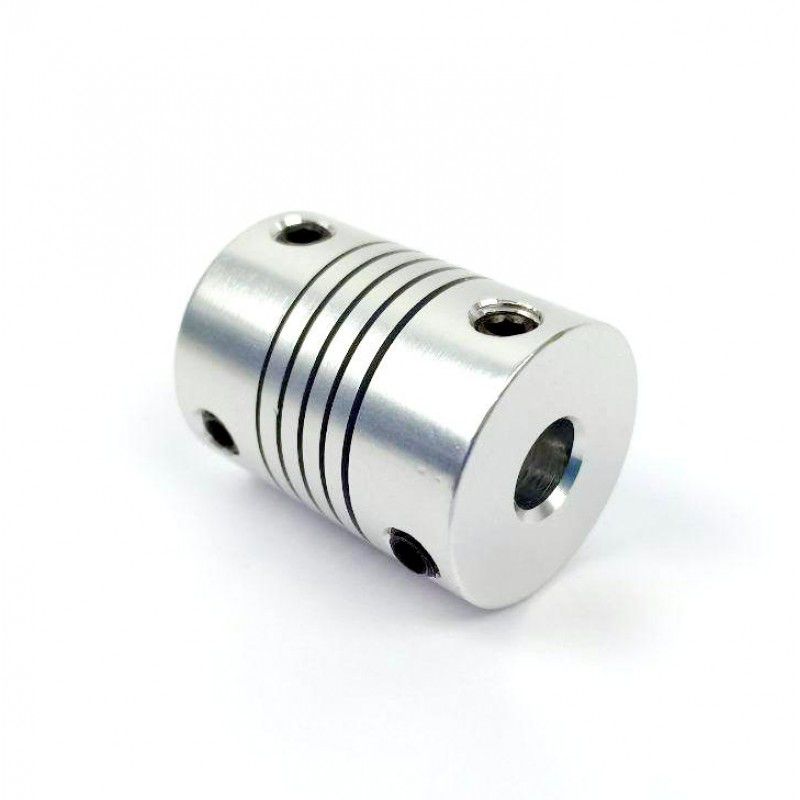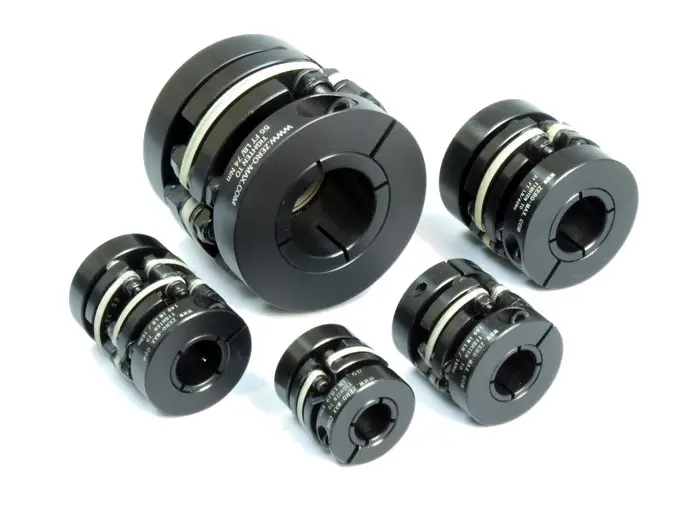Product Description
Flexible Spring Coupling GD Electrical High Torque Connection Elastic Coupling For Encoder Step Motor
Description of Flexible Spring Coupling GD Electrical High Torque Connection Elastic Coupling For Encoder Step Motor
>The main body is made of zinc alloy
>The middle elastomer is made of spring steel
>It has the advantages of simple structure, good flexibility, low inertia and less allowable angular deviation
>Easy installation, spring steel more effective compensation radial, shaft deviation
>Suitable for micro motor and encoder
>Fastening method of set screw
Catalogue of Flexible Spring Coupling GD Electrical High Torque Connection Elastic Coupling For Encoder Step Motor
|
model parameter |
common bore diameter d1,d2 |
ΦD |
L |
LF |
F |
M |
tightening screw torque |
|
GD-16 x27 |
5,6,6.35,7,8,9,10 |
16 |
27 |
8.5 |
3 |
M3 |
0.7 |
|
GD-16 x35 |
5,6,6.35,7,8,9,10 |
16 |
35 |
12.5 |
3.5 |
M4 |
1.7 |
|
GD-26 x50 |
6,6.35,7,8,9,10,11,12,12.7,14 |
26 |
50 |
17 |
4.5 |
M5 |
4 |
|
model parameter |
Rated torque(N.m) |
Maximum torque(N.M) |
maximum speed (rpm) |
moment of inertia(Kg.M2) |
allowable eccentricity(mm) |
allowable deflection angle(°) |
weight (g) |
|
GD-16 x27 |
0.5 |
1 |
3000 |
1.02×10-6 |
1 |
8 |
30 |
|
GD-16 x35 |
0.5 |
1 |
3000 |
1.02×10-6 |
1 |
8 |
70 |
|
GD-26 x50 |
1.5 |
3 |
3000 |
1.15×10-5 |
1.2 |
8 |
130 |
/* January 22, 2571 19:08:37 */!function(){function s(e,r){var a,o={};try{e&&e.split(“,”).forEach(function(e,t){e&&(a=e.match(/(.*?):(.*)$/))&&1

Can Motor Couplings Compensate for Angular, Parallel, and Axial Misalignments?
Yes, motor couplings are designed to compensate for different types of misalignments, including angular, parallel, and axial misalignments. The ability to accommodate misalignment is a key feature of motor couplings, and various coupling types offer different levels of misalignment compensation:
1. Angular Misalignment:
Angular misalignment occurs when the motor and driven equipment shafts are not perfectly aligned in the same plane, causing an angle between them. Motor couplings, especially flexible couplings, can effectively compensate for angular misalignment. Flexible couplings like jaw couplings, beam couplings, and oldham couplings can tolerate angular misalignment to a certain extent while transmitting torque smoothly.
2. Parallel Misalignment:
Parallel misalignment happens when the motor and driven equipment shafts are not perfectly aligned along their axis, leading to offset displacement. Flexible couplings, such as bellows couplings and disc couplings, are well-suited to accommodate parallel misalignment. These couplings can maintain good misalignment tolerance while providing high torsional stiffness for efficient torque transmission.
3. Axial Misalignment:
Axial misalignment occurs when there is a linear offset between the motor and driven equipment shafts along the axis. For some flexible couplings, a limited amount of axial misalignment can be tolerated. However, specific coupling types, such as self-aligning ball bearing couplings, are more suitable for handling higher levels of axial misalignment.
It is important to note that while motor couplings can compensate for misalignment, they have their limits. Excessive misalignment can lead to premature wear, reduced efficiency, and potential coupling failure. Proper alignment during installation and regular maintenance are essential to ensure the coupling’s misalignment compensation remains effective over time.
When selecting a motor coupling, consider the type and amount of misalignment expected in your application. Choose a coupling that offers the required level of misalignment compensation, ensuring smooth power transmission and extending the lifespan of the coupling and connected components.
“`
Explaining the Concept of Backlash and Its Impact on Motor Coupling Performance
Backlash is a critical factor in motor coupling performance and refers to the clearance or play between mating components within the coupling. In the context of motor couplings, it specifically relates to the amount of free movement or angular displacement that occurs when there is a change in direction of the driven shaft without a corresponding immediate change in the driving shaft.
Backlash in motor couplings can occur due to several factors:
- Manufacturing Tolerances: Variations in the manufacturing process can lead to slight clearances between coupling components, introducing backlash.
- Wear and Tear: Over time, the coupling components may experience wear, leading to increased clearance and backlash.
- Misalignment: Improper alignment between the motor and driven equipment shafts can cause additional play in the coupling, resulting in increased backlash.
The impact of backlash on motor coupling performance includes the following:
1. Reduced Accuracy:
Backlash can lead to inaccuracies in motion transmission. When the direction of rotation changes, the free play in the coupling must be taken up before torque can be effectively transmitted. This delay in motion transfer can cause positioning errors and reduced accuracy in applications requiring precise movements.
2. Vibration and Noise:
Excessive backlash can cause vibration and noise during operation. The sudden engagement of the coupling components after a change in direction can create shocks and vibrations that may affect the overall system performance and lead to premature wear of coupling components.
3. Reduced Efficiency:
Backlash results in power loss, especially in applications with frequent changes in direction. The energy required to take up the clearance in the coupling reduces the overall efficiency of power transmission.
4. Wear and Fatigue:
Repeated impacts due to backlash can accelerate wear and fatigue of coupling components, leading to a shorter lifespan and potential coupling failure.
5. Safety Concerns:
In certain applications, particularly those involving heavy machinery or high-speed operations, excessive backlash can pose safety risks. The lack of immediate response to directional changes can affect the control and stability of the equipment.
To mitigate the effects of backlash, it is essential to select motor couplings with low or controlled backlash and to maintain proper alignment during installation. Regular inspection and maintenance can help identify and address any increasing backlash, ensuring the motor coupling operates with optimum performance and reliability.
“`
Advantages of Using Motor Couplings in Various Mechanical Power Transmission Setups
Motor couplings offer several advantages in mechanical power transmission setups, making them a popular choice in various industries. Here are some key advantages of using motor couplings:
- Torque Transmission: Motor couplings efficiently transmit torque from the motor to the driven equipment, enabling the machinery to perform its intended task.
- Misalignment Compensation: Flexible motor couplings can accommodate misalignment between the motor and driven equipment shafts, reducing stress on bearings and increasing the system’s flexibility.
- Vibration Damping: Some motor couplings, particularly those with flexible elements, can dampen vibrations generated during motor operation, improving the overall system’s performance and reducing wear on connected components.
- Overload Protection: Motor couplings with torque-limiting features act as overload protection, preventing damage to the motor or driven equipment under excessive load or torque.
- Noise Reduction: Well-designed motor couplings can help reduce noise and resonance in the system, contributing to quieter and smoother operation.
- High Torque Capacity: Certain types of motor couplings, such as gear couplings, offer high torque capacity, making them suitable for heavy-duty applications.
- Misalignment Tolerance: Flexible couplings can handle both angular and parallel misalignment, ensuring smoother power transmission even in dynamic or changing conditions.
- Adaptability: Motor couplings are available in various types and sizes, making them adaptable to different motor and driven equipment configurations.
- Protection of Machinery: By dampening shocks and compensating for misalignment, motor couplings protect the machinery from premature wear and damage.
- Reduced Maintenance: Properly selected and installed motor couplings can reduce maintenance needs by minimizing wear on connected components and improving overall system reliability.
Motor couplings play a critical role in connecting motors to driven equipment, providing smooth and efficient power transmission while protecting the mechanical system from stress and wear. Proper selection and installation of the appropriate motor coupling type are crucial to maximizing these advantages and ensuring optimal performance in power transmission setups.
“`

editor by CX 2024-04-19
Leave a Reply